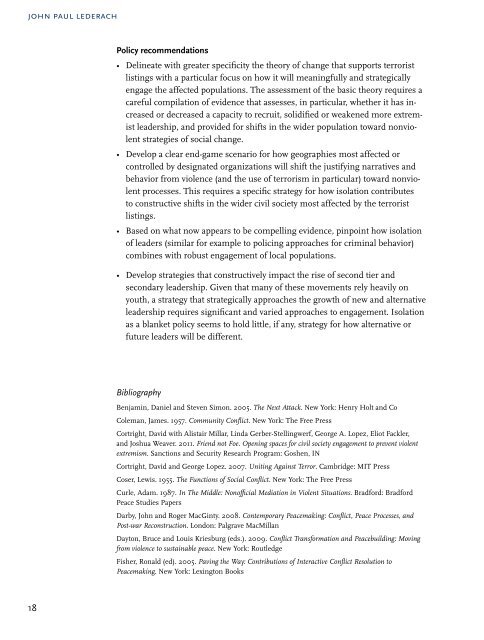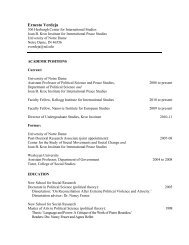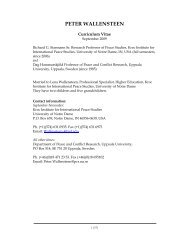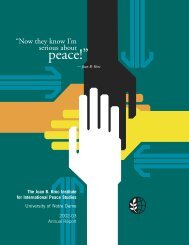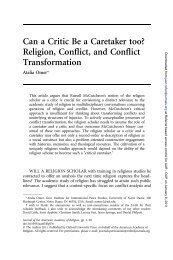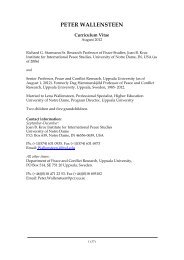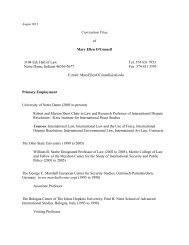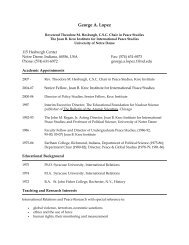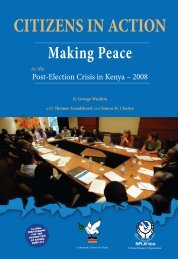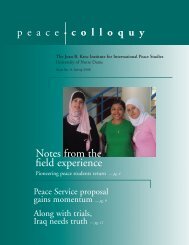Somalia: Creating Space for Fresh Approaches to Peacebuilding
Somalia: Creating Space for Fresh Approaches to Peacebuilding
Somalia: Creating Space for Fresh Approaches to Peacebuilding
You also want an ePaper? Increase the reach of your titles
YUMPU automatically turns print PDFs into web optimized ePapers that Google loves.
john paul lederach<br />
18<br />
Policy recommendations<br />
• Delineate with greater specificity the theory of change that supports terrorist<br />
listings with a particular focus on how it will meaningfully and strategically<br />
engage the affected populations. The assessment of the basic theory requires a<br />
careful compilation of evidence that assesses, in particular, whether it has increased<br />
or decreased a capacity <strong>to</strong> recruit, solidified or weakened more extremist<br />
leadership, and provided <strong>for</strong> shifts in the wider population <strong>to</strong>ward nonviolent<br />
strategies of social change.<br />
• Develop a clear end-game scenario <strong>for</strong> how geographies most affected or<br />
controlled by designated organizations will shift the justifying narratives and<br />
behavior from violence (and the use of terrorism in particular) <strong>to</strong>ward nonviolent<br />
processes. This requires a specific strategy <strong>for</strong> how isolation contributes<br />
<strong>to</strong> constructive shifts in the wider civil society most affected by the terrorist<br />
listings.<br />
• Based on what now appears <strong>to</strong> be compelling evidence, pinpoint how isolation<br />
of leaders (similar <strong>for</strong> example <strong>to</strong> policing approaches <strong>for</strong> criminal behavior)<br />
combines with robust engagement of local populations.<br />
• Develop strategies that constructively impact the rise of second tier and<br />
secondary leadership. Given that many of these movements rely heavily on<br />
youth, a strategy that strategically approaches the growth of new and alternative<br />
leadership requires significant and varied approaches <strong>to</strong> engagement. Isolation<br />
as a blanket policy seems <strong>to</strong> hold little, if any, strategy <strong>for</strong> how alternative or<br />
future leaders will be different.<br />
Bibliography<br />
Benjamin, Daniel and Steven Simon. 2005. The Next Attack. New York: Henry Holt and Co<br />
Coleman, James. 1957. Community Conflict. New York: The Free Press<br />
Cortright, David with Alistair Millar, Linda Gerber-Stellingwerf, George A. Lopez, Eliot Fackler,<br />
and Joshua Weaver. 2011. Friend not Foe. Opening spaces <strong>for</strong> civil society engagement <strong>to</strong> prevent violent<br />
extremism. Sanctions and Security Research Program: Goshen, IN<br />
Cortright, David and George Lopez. 2007. Uniting Against Terror. Cambridge: MIT Press<br />
Coser, Lewis. 1955. The Functions of Social Conflict. New York: The Free Press<br />
Curle, Adam. 1987. In The Middle: Nonofficial Mediation in Violent Situations. Brad<strong>for</strong>d: Brad<strong>for</strong>d<br />
Peace Studies Papers<br />
Darby, John and Roger MacGinty. 2008. Contemporary Peacemaking: Conflict, Peace Processes, and<br />
Post-war Reconstruction. London: Palgrave MacMillan<br />
Day<strong>to</strong>n, Bruce and Louis Kriesburg (eds.). 2009. Conflict Trans<strong>for</strong>mation and <strong>Peacebuilding</strong>: Moving<br />
from violence <strong>to</strong> sustainable peace. New York: Routledge<br />
Fisher, Ronald (ed). 2005. Paving the Way: Contributions of Interactive Conflict Resolution <strong>to</strong><br />
Peacemaking. New York: Lexing<strong>to</strong>n Books


